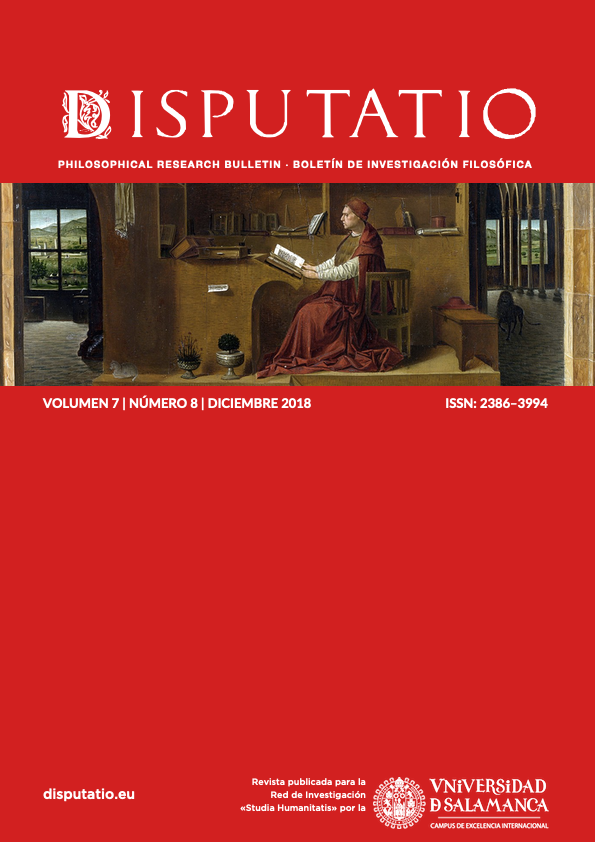Las emociones y su relación con la cognición: consideraciones sobre las objeciones de Anthony Kenny a las feeling theories
Resumen
En este trabajo me centro en las propuestas de William James (1884, 1890) y Anthony Kenny (1963) con el objetivo de mostrar que sus perspectivas se entienden mejor si son concebidas como propuestas de investigación con propósitos diferentes y ubicados en distintos ángulos de una investigación compleja en torno a las emociones. Adicionalmente, en tanto James y Kenny se conciben como autores paradigmáticos de las perspectivas no-cognitiva y cognitiva respectivamente, este modo de interpretación de sus posturas abriría un nuevo camino para el diálogo entre las tradiciones y sentaría nuevas bases para una reconciliación entre estas concepciones, en un marco más amplio.
Referencias
Brentano, Franz (1874). Psychologie vom Empirischen Standpunkt. Hamburg: Kraus.
Cannon, Walter B. (1927). The James–Lange Theory of Emotions: A Critical Examination and an Alternative Theory. The American Journal of Psychology 39, no. 1: pp. 106–124. https://doi.org/10.2307/1415404
Charland, Louis C. (1997). Reconciling Cognitive and Perceptual Theories of Emotion: A Representational Proposal. Philosophy of Science 64, no. 4: pp. 555–579. http://doi.org/10.1086/392572
Damasio, A. R. (1994). Descartes’ Error: Emotion, Reason and the Human Brain. New York: Grosset/Putnam.
Damasio, A. R. (1999). The Feeling of What Happens: Body and Emotion in the Making of Consciousness. New York: Harcourt Brace.
Deigh, J. (2014). William James and the Rise of the Scientific Study of Emotion. Emotion Review, 6(1), 4–12. https://doi.org/10.1177/1754073913496483
Dennett, D. (1969). Content and Consciousness. London: Routledge & Kegan Paul.
Dror, O. E. (2014). The Cannon–Bard Thalamic Theory of Emotions: A Brief Genealogy and Reappraisal. Emotion Review, 6(1), 13–20. http://doi.org/10.1177/1754073913494898
Ellsworth, P. C. (2014). Basic emotions and the rocks of New Hampshire. Emotion Review, 6(1), 21–26. http://doi.org/10.1177/1754073913494897
Ginnobili, S. (2007). Hay lo que queda. Sobre la presunta tautologicidad de la teoría de la selección natural. Análisis Filosófico, XXVII(1), 75–89.
Goldie, P. (2000). The Emotions: A Philosophical Exploration (Vol. 53). Oxford University Press.
Gosling, J. C. (1965). Emotion and Object. The Philosophical Review, 74(4), 486–503. https://doi.org/10.2307/2183125
Griffiths, P. E. (1997). What emotions really are: The problem of psychological categories. University of Chicago Press Chicago. https://doi.org/10.7208/chicago/9780226308760.001.0001
Hacker, P. M. S. (2004). The Conceptual Framework for the Investigation of the Emotions. International Review of Psychiatry, 16(3), 199–208. https://doi.org/10.1080/09540260400003883
Hacker, P. M. S. (2009). The Conceptual Framework for the Investigation of Emotions. En Y. Gustafsson, C. Kronqvist, & M. McEachrane (Eds.), Emotions and Understanding: Wittgensteinian Perspectives. Palgrave Macmillan. https://doi.org/10.1057/9780230584464_4
James, W. (1884). What is an emotion? Mind, 9, 188–205. https://doi.org/10.1093/mind/os–IX.34.188
James, W. (1890). Principles of Psychology. Chicago: Enciclopaedia Britannica, Inc.
Kandel, E. R., Schwartz, J. H., & Jessell, T. M. (1997). Neurociencia y conducta. Prentice Hall.
Kenny, A. (1963). Action, Emotion, and Will. Wiley–Blackwell.
Kenny, A. (1989). The Metaphysics of Mind. Oxford University Press.
Kuhn, T. S. (1990). Dubbing and Redubbing: the Vulnerability of Rigid Designation. (C. W. Savage, Ed.)Minnesota Studies in the Philosophy of Science. Minneapolis: University of Minnesota Press.
Laird, J. D., & Lacasse, K. (2013). Bodily Influences on Emotional Feelings: Accumulating Evidence and Extensions of William James’s Theory of Emotion. Emotion Review, 6(1), 27–34. http://doi.org/10.1177/1754073913494899
Lange, C. G. (1885). Om sindsbevaegelser: Et psyko–fysiologisk studie. Copehhagen: Jacob Lunds.
Lewis, M. (2008). The emergence of human emotions. En M. Lewis, J. Haviland–Jones, & L. F. Barrett (Eds.), Handbook of Emotions, Third edition (pp. 304–319). New York: The Guilford Press.
Lorenzano, P. (2008). Lo a priori constitutivo y las leyes (y teorías) científicas. Revista de Filosofía, 33(2), 21–48.
Lyons, W. (1980). Emotion. Cambridge: Cambridge University Press. https://doi.org/10.1017/CBO9780511609244
Marks, J. (1982). A Theory of Emotions. Philosophical Studies, 42, 227–242. https://doi.org/10.1007/BF00374036
Melamed, A. F. (2015). La naturaleza de las emociones, entre la cognición y la percepción. En P. Lorenzano, C. Abreu, J. Ahumada, L. Federico, S. Ginnobili, M. de las M. O’Lery, & L. Salvatico (Eds.), Selección de trabajos presentados en el VIII Encuentro de Filosofía e Historia de la Ciencia del Cono Sur (pp. 85–91). Universidad Nacional de Córdoba.
Melamed, A. F. (2016). Las teorías de las emociones y su relación con la cognición: un análisis desde la filosofía de la mente. Cuadernos. Revista de la Facutlad de Humanidades y Ciencias Sociales de la Universidad Nacional de Jujuy, 49, 13–38.
Pérez, D. I. (2013). Sentir, desear, creer. Buenos Aires: Prometeo Libros.
Prinz, J. J. (2003). Emotions Embodied. Perception, 1–14.
Prinz, J. J. (2004). Gut Reactions: A Perceptual Theory of Emotion. New York: Oxford University Press.
Prinz, J. J. (2005). Are Emotions Feelings? Journal of Consciousness Studies, 12(8–10), 9–25.
Prinz, J. J. (2006). The Emotional Basis of Moral Judgments. Philosophical Explorations, 9(1), 29–43. http://doi.org/10.1080/13869790500492466
Quine, W. V. O. (1953). Two Dogmas of Empiricism. En From a Logical Point of View. Harvard University Press.
Reisenzein, R., & Stephan, A. (2014). More on James and the Physical Basis of Emotion. Emotion Review, 6(1), 35–46. http://doi.org/10.1037/0033-295X.102.4.757
Robinson, J. (2005). Deeper than Reason. New York: Oxford University Press. http://doi.org/10.1093/0199263655.001.0001
Wilson, J. R. S. (1972). Emotion and Object (Vol. 23). Cambridge University Press. https://doi.org/10.1017/CBO9780511735813.
Derechos de autor 2018 © Disputatio

Esta obra está bajo licencia internacional Creative Commons Reconocimiento-NoComercial-SinObrasDerivadas 4.0.
Derechos de autor y política de acceso abierto: https://studiahumanitatis.eu/ojs/index.php/disputatio/policies/copyright



